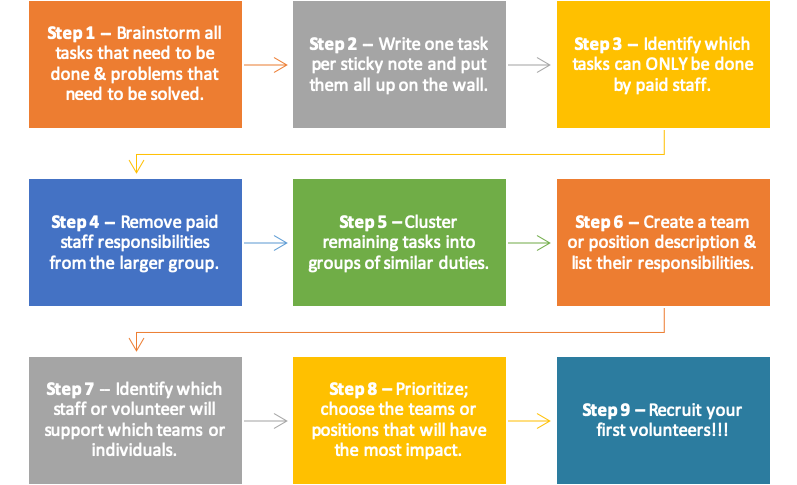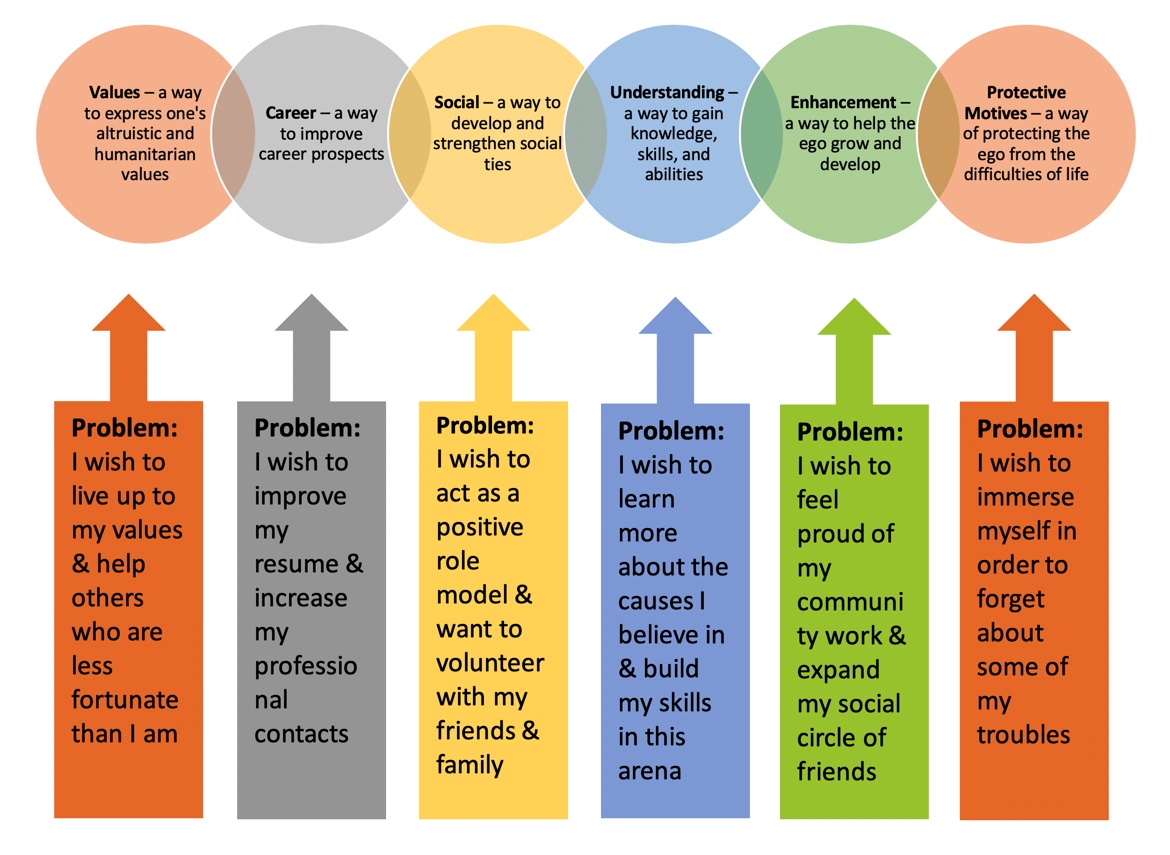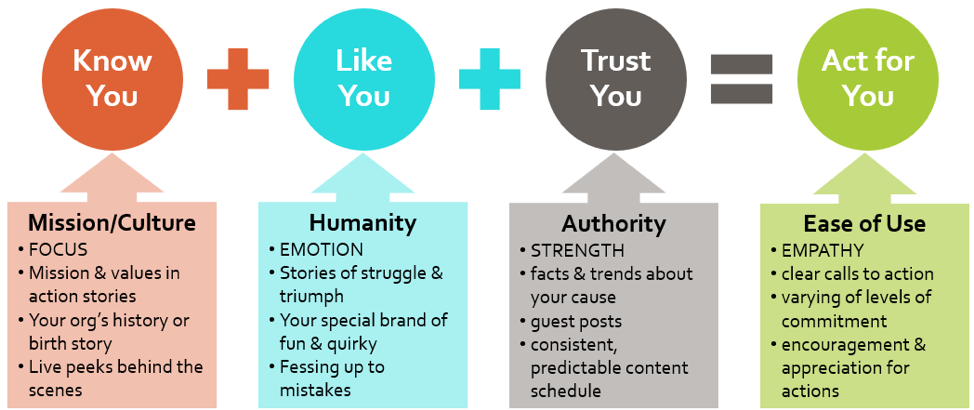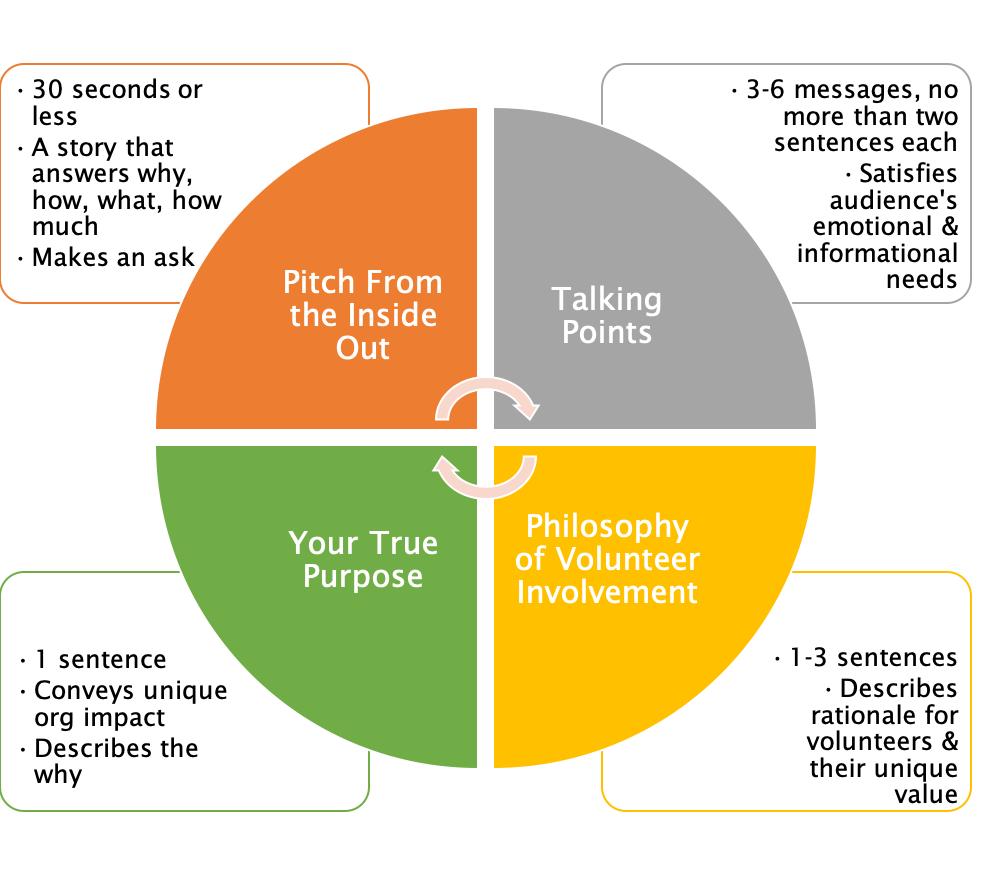
Chapter 2: Volunteer Recruitment
Are you looking for creative ways to recruit volunteers? Having trouble finding volunteers that match your volunteer personas or ideal audiences? Want to learn how to get people to volunteer that actually have the time and skills you need? Or perhaps you want to focus your volunteer recruitment messaging to get the right volunteers knocking at your door.
Effective volunteer recruitment is a building process. You can’t start recruiting volunteers until you’ve set the foundation of your volunteer program, which involves plenty of legwork such as conducting an organizational needs analysis, identifying roles and responsibilities of staff, and designing accurate volunteer job descriptions. Once this groundwork is completed, you’ll have the buy-in and framework in place to add volunteers to your team.
And there begins the fun part.
The goal of volunteer recruitment is to bring in committed individuals that will help further your mission and advocate for your cause. There are many creative ways you can recruit volunteers through personal networking, special events, presentations, and digital advertising. We’ll explain how to develop volunteer personas and how to use them to capture attention. We’ll also share how to get an applicant from interest to investment, as well as tips on how you can say “no” when you have to.
Excited to learn more? Let’s start building!
Needs Analysis
First things first. Before you start recruiting volunteers, you’ll want to build a foundation by conducting a needs analysis to determine which volunteer roles and what staff support are needed within your nonprofit. Make sure to include both staff and volunteers in this process. Below is a step-by-step method that can be accomplished in an afternoon. Assemble a small team to work it through. All you need are some markers, a pad of medium size sticky notes, and a blank wall.
Process for Volunteer Role Design

Creating Volunteer Position Descriptions
Before volunteer recruitment can begin, one of the most time-consuming tasks is developing the volunteer position descriptions. Volunteer position descriptions are important in that they map out clear expectations and communicate clear, fair boundaries for volunteers.
They help the volunteer answer that all-important question: “Will this work matter?” They also help volunteers understand what’s expected and how they can integrate the time requirements into their busy lives. A good volunteer position description should explain the assignment thoroughly, outline the skills needed to perform the tasks successfully, and specify the type of training and support they will receive.
Mapping Volunteer Roles
After you’ve developed your volunteer position descriptions, it’s also a good idea to map out the number of volunteers you will have in each type of role. This will give you a “bird’s eye” view of the variety (or lack thereof) of current volunteer involvement across your organization. You can also list the ideal number of supporters you wish to have in each role or the ideal number of hours per month needed to support that role adequately.
Your volunteer roles can be divided into categories including one-time events, project-based teams, specialized or skills-based, or traditional long-term. Share the results with the whole organization so all departments can see how volunteers will be involved. At this stage, you’ll want to prioritize the volunteer positions that will have the most impact and identify seasoned volunteers to support and train your desired volunteer teams.
Identifying staff to support your volunteer program
As you develop volunteer roles, you’ll also want to identify the staff who will be responsible for supporting them at each stage of the volunteer lifecycle from volunteer recruitment to recognition. Also, if you include both staff and volunteers in the needs analysis phase, to help determine roles and goals for volunteers, you establish buy-in for your program. This is significant so everyone in the organization can feel invested in the volunteer program plan, be ready to support it, and be excited when advocating for it.
Make sure to include any volunteer management responsibilities in their job descriptions, too. Refer to Chapter 1 for ideas. You may also refer to the Volunteer Lifecycle for the list of phases for specific duties. Some staff may be responsible for their own volunteer teams and have all the duties associated with volunteer coordination. Or, they may only be responsible for one stage in the lifecycle (e.g. Training: Conduct advanced training to volunteers in sanitation procedures).
How Do You Find Volunteers?
You’ve laid the groundwork for your program, now you’re ready to start the volunteer recruitment process! There are four main ways to find volunteers:
1. Personal Networking
It has been proven that using personal connections to recruit for paying jobs is one of the most effective ways to fill positions. This is no different for volunteer work. Every organization has contacts, whether they are clients, supporters, partners, or former volunteers. Plus, all staff have their own set of friends and family. Start there. Talk to people you know who might share the values of your cause. It is more likely you will persuade someone you know to volunteer over complete strangers.
2. Special Events
You can recruit volunteers through different types of events. This could be through an open house that you hold at your organization or at an upcoming local event at a partner location. Holding an event at your location gives potential volunteers an opportunity to get a feel for your organization’s environment, meet the staff and other volunteers, and possibly interact with clients. It’s a great way to show how your programs impact the community. And don’t forget to offer free food or giveaways with your logo. People love free stuff!
3. Community Presentations
Another way to recruit volunteers is by making presentations in the community. It creates publicity for your organization and shows your care for the community, which hopefully, will attract new volunteers. You can make presentations to schools, churches, college organizations, scout groups, or businesses where people are looking for ways to help their community. Even more effective would be to bring a volunteer and/or client with you to the presentation. There’s nothing better than hearing testimonials and stories directly from people who aren’t paid staff.
4. Advertising & Posting
Finally, you can post enticing volunteer recruitment ads through flyers, rack cards, posters, social media, or email campaigns. You’ll want to develop materials that grab attention, clearly communicate your higher purpose, and appeal to people’s emotions. Marketing isn’t about manipulation. It’s about helping your audience connect with something that can make their lives better.
Persuading With Words
Persuasive copywriting grabs attention, persuades the reader to consider your point of view, and inspires them to act (or what marketers call “conversion”). The same goes for your volunteer recruitment appeals.

Marketing is most effective when it elevates your audience and what you are trying to accomplish. Clearly communicate your higher purpose.
Most of what people read today is on a small screen, so brevity is an asset. Here’s a simple formula you can use to write up a short, compelling volunteer recruitment posting:
- What’s the Problem? – Community problem or volunteer problem
- What’s the Solution? – Your organization’s solution to the problem
- What’s Involved? – The training, support, a few details
- What Do You Need Me to Do? – Your Call to Action
Your Big Volunteer Recruitment Idea
All it takes is one big recruitment idea – your thesis. This thesis should describe the one big reason why volunteers should join your cause and how their involvement will make an impact in a way they care about. It should address a key volunteer “problem” (see more on what we mean by “problems” below). This thesis will guide you as you develop the rest of your recruitment campaign messages.
Copy Thesis Formula:
Any [type of volunteer you seek] can [solve their problem] by volunteering for your cause because [how it solves their problem].
For Example:
“Anyone who cares about our neighborhood health can help keep it clean and green by volunteering for the West Town Greenway — we will show you how to educate kids on easy ways to reduce pollution.”
Developing Effective Volunteer Recruitment Messages
Once you have your thesis ready to go, you can start developing your recruitment messages. These should be focused on your nonprofit’s ability to meet volunteer needs. Below are six well-researched motivations for volunteering and the volunteer “problem” or need that each serves.
Focus on only 1-2 per campaign and build your messaging around them. If possible, include volunteer quotes or testimonials to offer proof that the “problem” is “solved” or the need met.

Appeal to Emotions
Appeal to emotions when putting together your content. An analysis of 1400 case studies of successful advertising campaigns found some interesting results. It showed that campaigns with purely emotional content performed about twice as well than those with only rational content, and those that were purely emotional did a little better those that had mixed content.
Tactics include using pictures or power words that evoke emotion. Research has also shown that the following words light up the brain and are the most effective in promoting action. However, you must understand why these words are persuasive in order to use them in the contexts that make sense for your audience.
- You – write as though you’re speaking to the potential volunteer and not about yourself
- Free – getting something for free excites people and creates the desire for more
- Because– explain why volunteers are needed or why the nonprofit does what it does
- Instantly or Immediately – let them know when you’ll be in touch, when they can start, or how fast they can make a difference
- New – can be a new program, initiative, project, campaign, or training cycle
Find ways to integrate these into your calls-to-action, headlines, email subject lines, headings, opening sentences, and paragraphs to bump up their effect. Think about how you can use these words to encourage community, make claims sound rational, increase urgency, or promote social sharing.
Using Digital Channels to Build a Fan Base
More and more, simple and direct is the best way to communicate in the digital world. Boost awareness by building relationships. People will likely not respond to your appeal unless they feel that they know, like, and trust you. Think about ways you can share this information both on and offline.

Here are some examples of the kinds of blog posts, newsletter articles, or social media content that would interest prospective volunteers:
- Your organization’s history (our birth story) – to offer a sense of continuity, even for younger nonprofits
- Customer or volunteer interview – focuses on client results
- Volunteer or intern appreciation – to let folks know how volunteers are moving mountains
- Your latest blog or newsletter article + a request to subscribe – to entice them to read more
- A small ask (e.g. advocacy) – to propel the momentum toward supporting you
- A volunteer’s story + call to action – to give volunteers hope they can make change happen
- An event – where people can meet you in person
- Special day or celebration – so it’s not always just about you
- Something cute – to show how much fun they can have
Don’t forget, if you want two-way engagement, you need to schedule time to listen and respond to people’s responses. Make sure you follow-up. This small action can help you “seal the deal.”
Addressing Objections to Volunteering
It helps to have a plan in place to proactively address any concerns prospective volunteers may have about supporting your cause. Most requests or offers are met with 3-5 common objections.
Identify the most common you encounter from prospective volunteers and answer them in your ad copy. You’ll be more successful if you can counter doubts before they are even expressed. For examples of potential objections and possible responses, download our eBook: The Ultimate Guide to Enthusiastic, Effective Successful Volunteer Involvement at Your Nonprofit.
Here is a basic messaging platform that will help you develop a full suite of messages to use on any occasion to compel current or prospective volunteers to action.

When You Have to Say “No”
It’s easy to overlook the possibility that our successful volunteer recruitment efforts could end up with more volunteer applicants than you can handle. A good problem to have, right?
There are also times when you may need to reject an application because of a bad match. And, sometimes having to say “no” may be because of ill-preparation on the side of the organization. Saying “no” to a potential volunteer might seem difficult, but it doesn’t have to be. You also do not want to put you or the organization at risk. So, if you are not comfortable, don’t make an exception “just this one time.”
Here are some examples of when you should not bring on a volunteer and how to handle each situation.
- The task is not well-designed
If during the interview process, you discover you are not getting the right volunteers for your positions, you may want to re-examine your position descriptions.
- The volunteer is unprepared or unwilling to do the task
In this situation, you will need to address the issue head on. Be honest with them and let them know what is required of the position.
- Adequate resources are not available to complete the task
You may not have enough resources to assist a large number of volunteers. Let the applicant know this and ask them if they would be willing to be put on a reserve list to be called up when new opportunities arise. Or, refer them to another organization.
- There are unresolved issues or conflicts between staff-volunteers
If the current environment between your staff and volunteers is tense, you will want to address those issues first before taking on new volunteers. Call a meeting to discuss and resolve the problems together and schedule an in-service training for both staff and volunteers if necessary.
- Volunteer does not pass a background check
This is an easy one. If a volunteer does not pass your background check requirements, they simply cannot volunteer and put your organization at risk.
It’s always best to tell a potential volunteer verbally the reasons why you are not able to take them on, but it’s also good to put it in writing. If a volunteer isn’t a good match or didn’t pass the background check, you may want to set up a regrets letter template for those rare cases.
Invest Time to Reap the Real Rewards of Volunteer Recruitment
Remember, volunteer recruitment depends on how well you can get others to advocate for your mission and help you realize your vision. Having great people behind your cause is key. Take the time to hone your volunteer recruitment process and get the buy-in you need to make it soar. You can still be creative while being effective, so stick to your message but let your inspiration fly.
Learn More with Our Free eCourse: Better Volunteer Recruitment in 6 Easy Steps
In this e-mail delivered course, we’ll share a vision of how volunteers can help deliver your mission and how you can attract the right people for the right jobs. You’ll get practical strategies you can put to use right away.
Here’s what you can expect:
- A clear explanation of volunteer recruitment broken down into six easy steps, in seven emails delivered every few days
- A helpful downloadable tool with each step to take action toward better volunteer recruitment

